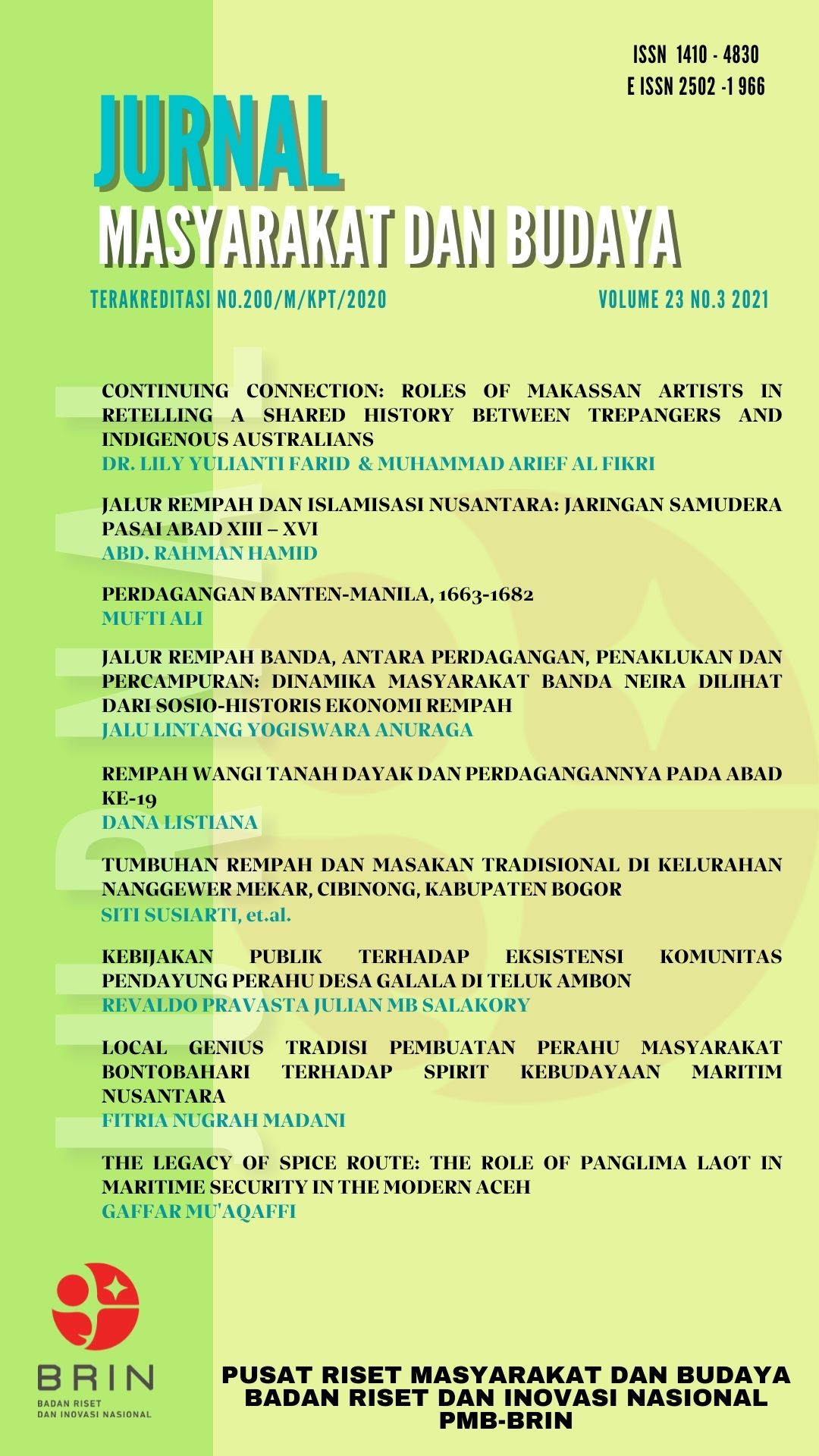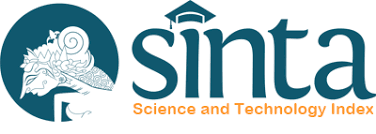Continuing Connection
Roles of Makassan Artists in Retelling a Shared History between Trepangers and Indigenous Australians
DOI:
https://doi.org/10.14203/jmb.v23i3.1484Keywords:
Indigenous Australia; Makassar; cultural relations, Indigenous Australia, Makassar, cultural relations, trepang, stroytelling, education, maritime heritageAbstract
The historical relationships between Makassans and Aboriginal people that took place as early as the 17th century until the early 20th century through the trepang industry in the northern coast, North Australia, is still unknown to many people in Makassar, South Sulawesi. There are various factors involved in the lack of information about the shared history, including the absence of the story of trepangers as part of Indonesian maritime heritage history in school textbooks and the insufficient materials and narratives on this topic in provincial and city museums. This paper examines the potential roles of Makassan artists and cultural activists to tell the story after engaging with ancient trepang industry-related cultural and art projects. It also investigates their changed perceptions about Australia and Indonesia both culturally and historically after their participation in art and cultural projects.
Downloads
References
References
Arena Magazine 45 (2000, February). Trepang Opening Night. February 2000. Retrieved from https://arena.org.au/trepang-opening-night/
Australian Embassy, Indonesia (2017, August). The Voyage to Marege: A Musical Celebration of Australia and Indonesia;s Shared Histories. Retrieved from https://indonesia.embassy.gov.au/jakt/MR17_057.html
Baillie, A (1994). Songman. Melbourne: Viking.
Bilous, Rebecca H. (2011). Macassan/Indigenous Australian ‘sites of memory’ in the National Museum of Australia and Australian National Maritime Museum. Australian Geographer, 42:4, 371-386, doi: 10.1080/00049182.2012.619953.
Bilous, Rebecca H. (2015). Making Connections: Hearing and sharing Macassan-Yolηu Stories. Asia Pacific Viewpoint, 56 (3): 356-379.
Clark, Marshall. (2013). Tangible Heritage of the Macassan–Aboriginal Encounter in Contemporary South Sulawesi. In M. Clark and S.K. May (Eds.), Macassan history and heritage: Journeys, encounters and influences (pp. 159–181). Canberra: ANU E Press.
Ganter, R. (2006). Mixed Relations: Asian/Aboriginal contact in north Australia. Perth: University of Western Australia Press.
Macknight, Charles Campbell. (1976). The Voyage to Marege’, Macassan Trepangers in Northern Australia. Melbourne: Melbourne University Press.
McIntosh, I. (2000). Aboriginal Reconciliation and the Dreaming: Warramiri Yolngu and the Quest for Equality. Boston: Allyn and Bacon.
Morphy, H. (1991). Ancestral Connections: Art and an Aboriginal System of Knowledge. Chicago: University of Chicago Press.
Poelinggomang, E. (2004). Perubahan Politik dan Hubungan Kekuasaan Makassar 1906-1942. Yogyakarta: Penerbit Ombak.
Stephenson, P. (2007). The Outsiders Within: Telling Australia’s Indigenous–Asian story. Sydney: UNSW Press.
Yulianti, L. (2019). Makassar and Northern Australia: An artistic perspective of the shared history. International Institute for Asian Studies.Retrieved from https://research.monash.edu/en/publications/makassar-and-northern-australia-an-artistic-perspective-of-the-sh
Interviews
Febrianty Hasanah. September 2020.
Mansyur Muhayang. 5 December 2020, 27 March 2021.
Muhammad Rais. February 2019, September 2020.
Nurabdiansyah Ramli. February 2019, September 2020.
Syarifuddin Daeng Tutu. September 2020.
Will Stubbs. December 2018.
Published
Issue
Section
Copyright (c) 2022 Lily Yulianti Farid , Muhammad Arief Al Fikri

This work is licensed under a Creative Commons Attribution-NonCommercial-NoDerivatives 4.0 International License.
Authors who publish with this journal agree to the following terms:
- The copyright for articles in this journal is retained by the authors.
- Authors grant to the journal first publication rights and the right to distribute the article, including the journal's web site, online data bases and other similar forms.
- Authors agree to license their work according to Creative Commons Attribution-NonCommercial-NoDerivatives 4.0 International License.
- Articles published in JMB are free to use for non-commercial uses as long as the authors and the journal are attributed properly and the new creations are licensed under the indentical terms (license Creative Commons (CC BY-NC-ND 4.0).
- Authors retain the right to reproduce and distribute their articles in any format, without prior authorization, with the proper acknowledgment to the first publication.
- If the article contains copyright material owned by others, authors should obtain written permission from the copyright owner/s in order to reuse the material. Appropriate acknowledgment should be included.
- Authors are encouraged to post their article online (in institutional repositories, personal websites etc). Any such posting must include a reference and a link to the journal's website.
Penulis yang menerbitkan pada jurnal ini menyetujui ketentuan berikut:
- Hak cipta untuk artikel dalam jurnal ini disimpan oleh penulis.
- Penulis memberikan kepada jurnal hak publikasi pertama dan hak untuk mendistribusikan artikel, termasuk situs web jurnal, basis data online dan bentuk serupa lainnya.
- Penulis setuju untuk melisensikan karya mereka sesuai dengan Creative Commons Attribution-NonCommercial-NoDerivatives 4.0 International License.
- Artikel yang diterbitkan dalam JMB bebas digunakan untuk penggunaan non-komersial selama penulis dan jurnal dikaitkan dengan benar dan kreasi baru dilisensikan menurut istilah indentis (lisensi Creative Commons (CC BY-NC-ND 4.0).
- Penulis mempertahankan hak untuk mereproduksi dan mendistribusikan artikel mereka dalam format apa pun, tanpa izin sebelumnya, dengan pengakuan yang tepat untuk publikasi pertama.
- Jika artikel tersebut berisi materi hak cipta yang dimiliki oleh orang lain, penulis harus mendapatkan izin tertulis dari pemilik hak cipta untuk menggunakan kembali materi tersebut. Pengakuan yang tepat harus disertakan.
- Penulis didorong untuk memposting artikel mereka secara online (dalam repositori institusional, situs web pribadi dll). Setiap posting seperti itu harus menyertakan referensi dan tautan ke situs web jurnal.

.png)









